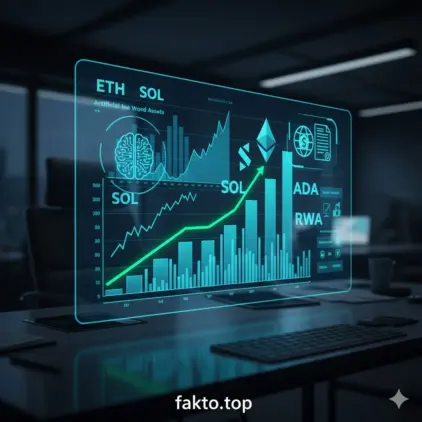Top Altcoins 2025–2026: Forecast, Trends & Investment Picks (RWA, AI, Layer-1)
The crypto investment landscape in 2025 is shifting from speculation to substance. After years of noise and meme mania, investors are turning to altcoins that actually solve problems—bridging blockchain with artificial intelligence, real-world assets (RWA), and high-speed Layer-1 infrastructure. Altcoins are no longer experimental; they are the backbone of Web3 utility and adoption.
This altcoin market outlook dives into where capital, innovation, and user activity are converging. Ethereum and Solana continue to lead decentralized finance and scalability, but new players like SUI and HYPE are redefining what performance and intelligence mean on-chain. Each of these networks carries its own narrative, driven by technology, ecosystem growth, and developer momentum.

The 2025 bull cycle is forming around three main pillars: tokenized assets (RWA), AI integration, and cross-chain interoperability. These aren’t hype trends—they’re the mechanisms that will define the next wave of crypto adoption. Altcoins tied to these narratives are gaining traction as infrastructure-level investments rather than short-term trades.
This analytical hub will separate the noise from the signal. We’ll examine both blue-chip assets with proven track records and high-conviction emerging coins that could define 2026. Each section emphasizes data, fundamentals, and on-chain metrics—because in this cycle, utility will matter more than memes.
Altcoin Blue Chips: The Foundation
Ethereum (ETH): The Indispensable L1 and DeFi King
Ethereum remains the most critical Layer-1 blockchain, powering DeFi, NFTs, and smart contract ecosystems. Its Proof-of-Stake model ensures energy efficiency and scalability improvements, while Ethereum’s network effect attracts developers, institutional capital, and cross-chain integrations. In 2025, ETH continues to dominate as the primary infrastructure for decentralized applications.
Cardano (ADA): The Academic Blockchain
Cardano focuses on long-term sustainability, peer-reviewed development, and secure smart contracts. Its low energy footprint and research-driven approach make it attractive for real-world adoption, especially in education, identity systems, and RWA applications. ADA is valued for predictable governance and strong developer alignment.
Litecoin (LTC): Fast and Cheap Payments
Litecoin serves as a reliable, low-cost payment network. Its high transaction speed and decentralized nature make it ideal for retail payments and P2P transfers. While not a hub for complex dApps, LTC’s utility in transactional flows secures its status among blue-chip altcoins.
Ripple (XRP): The Bank-Friendly Coin
XRP is optimized for cross-border payments and financial institutions. Despite ongoing regulatory challenges, XRP’s network is expanding globally, particularly in Asia and Latin America. Its real-world adoption in banking infrastructure reinforces its long-term relevance.
Polkadot (DOT): The Cross-Chain Connector
Polkadot enables interoperability between independent blockchains, supporting developers building multi-chain applications and parachains. DOT is gaining traction in enterprise and infrastructure projects. Its cross-chain bridging capabilities position it as a critical component of the 2025–2026 ecosystem.
Chainlink (LINK): The Oracle King
Chainlink connects off-chain data to smart contracts, enabling DeFi and dApp functionality. It remains indispensable for decentralized information feeds like pricing, weather, and event data. LINK’s role as the bridge between real-world data and blockchain execution is unmatched.

Solana (SOL): Speed Demon of Web3
Solana delivers high-speed transactions with low fees, ideal for NFTs, DeFi, and gaming. Despite past network outages, its ecosystem continues to grow. SOL represents the scalability pillar of Web3 infrastructure, supporting large-scale adoption and complex dApps.
Emerging Trends & High-Conviction Plays
SUI Network (SUI): Newcomer With Momentum
SUI is a scalable Layer-1 blockchain optimized for user-friendly dApps. Its growing developer activity and strategic integrations, such as stablecoin support (USDT), enhance adoption potential. Analysts suggest SUI may reach the $5–$6 range in 2025, driven by ecosystem growth and developer engagement, though forecasts remain conditional on market dynamics.

Scaling & Infrastructure Comparison
This table compares the core architectural and performance metrics of leading altcoins, helping investors understand how each project addresses scalability, security, and real-world application potential.
| Metric | Ethereum (L2) | Solana (L1) | Polkadot (L0/L1) | SUI Network (L1) |
|---|---|---|---|---|
| Architecture | Modular (L1 + L2 Rollups) | Monolithic (Single Chain) | Heterogeneous Multi-chain (Relay + Parachains) | Object-Centric (Move) |
| Max Theoretical TPS | ~100,000+ (with L2s) | ~65,000 | ~1,000,000 (future) | ~120,000 |
| Finality Time | ~10–15 minutes (L1) | ~0.4 seconds | ~6–12 seconds | Sub-second (Simple TXs) |
| Core Value Proposition | Security, Decentralization, DeFi | Raw Speed, Consumer Apps, Low Fees | Interoperability, Shared Security | Parallel Processing, Gaming, Asset Ownership |
| Primary Risk | High L2 Fees / L1 Congestion | Network Outages / Centralization Concerns | Parachain Slot Competition | Developer Adoption / New Technology |
Hyperliquid (HYPE): AI Meets Crypto
HYPE integrates machine learning into blockchain analytics, offering predictive insights for decentralized applications. Its AI-driven framework positions it within the high-growth AI + crypto narrative. While early-stage, HYPE’s utility-focused approach sets it apart from purely speculative tokens.
USUAL: Stablecoin With a Twist
USUAL is a decentralized fiat-backed stablecoin platform supported by Binance Labs and Kraken Ventures. With $1.6B+ in TVL, it underpins cross-chain liquidity and payment solutions. Its adoption in infrastructure and payment rails makes it a high-conviction asset for the emerging stablecoin ecosystem.
These high-risk, high-reward altcoins are not about hype—they reflect technological innovation, ecosystem expansion, and real-world utility. Investors should monitor on-chain metrics, developer activity, and strategic integrations when assessing potential.
The 2026 Catalyst: Mega-Trends Shaping the Next Cycle
The next phase of crypto evolution will be driven by real-world asset tokenization (RWA), artificial intelligence integration, and cross-chain infrastructure. Altcoins are no longer isolated experiments—they are building the rails for decentralized finance, gaming, identity, and data ecosystems.
Trend Exposure: AI & RWA
This table highlights which altcoins are best positioned to capitalize on the major 2026 narratives—AI integration and real-world asset (RWA) tokenization. It emphasizes practical applications and growth catalysts.
| Altcoin | Primary Trend Focus | Specific RWA/AI Application | 2026 Growth Catalyst |
|---|---|---|---|
| Chainlink (LINK) | RWA / Oracle | Bridge for institutional data (TradFi to DeFi) | Tokenization of real-world assets (BlackRock, etc.) |
| XRP (Ripple) | RWA / Payments | Cross-border institutional liquidity | Expansion in Asia/MENA corridors |
| Cardano (ADA) | RWA / Identity | Decentralized Identity (DID) for supply chains | Government/Educational adoption in developing nations |
| Hyperliquid (HYPE) | AI / DeFi | AI-driven predictive trading and analytics | New machine learning model integrations |
| USUAL | RWA / Stablecoin | Fiat-backed platform for cross-chain liquidity | Institutional demand for compliant on-chain yield |
| SUI Network (SUI) | RWA / Platform | Optimized for asset tokenization and ownership (Move) | Launch of major RWA protocols on the chain |
Tokenized Real-World Assets
Altcoins are increasingly enabling fractional ownership of tangible assets—real estate, stocks, carbon credits, and music royalties. Platforms like Avalanche, Polygon, and SUI provide the infrastructure for this shift. In 2026, investors will access global assets on-chain with transparency and liquidity previously impossible in traditional markets.
AI Integration
Artificial intelligence is becoming embedded in blockchain networks. From predictive analytics in DeFi to smart contract automation, AI-enabled altcoins such as Hyperliquid demonstrate how machine learning enhances utility and adoption. This trend is expected to accelerate in the 2025–2026 cycle.
Infrastructure & Layer-1 Evolution
Scalability, interoperability, and developer-focused upgrades define Layer-1 networks’ growth. Ethereum continues to lead in adoption and cross-chain integrations, while Solana and Polkadot push performance and multi-chain connectivity. These blue-chip and emerging platforms form the backbone for next-cycle innovation, emphasizing functionality over speculation.
Overall, the 2026 catalyst is clear: altcoins that integrate RWA, AI, and robust Layer-1 infrastructure will drive adoption and market leadership, setting the stage for sustainable growth beyond mere price action.
Altcoin FAQ: What to Expect in 2026
Will altcoins still be relevant in 2026?
Absolutely. Altcoins with real utility, active development teams, and growing ecosystems will continue to thrive. Tokens lacking fundamentals or speculative-only narratives are likely to fade. Expect consolidation, regulation, and increased adoption of tokenized assets and AI-driven platforms.
Which altcoins have the best long-term potential?
Ethereum remains dominant, while Solana, Chainlink, Polkadot, and SUI show strong growth potential. Look for coins with developer activity, Layer-2 support, cross-chain capabilities, and RWA integrations.
Is it too late to invest in altcoins?
Not necessarily. The market is evolving, and 2026 introduces new narratives: AI + crypto, RWAs, decentralized social media, and tokenized governance. Altcoins will play a central role in these innovations.
What risks should I watch out for?
Regulatory challenges, low liquidity, and weak tokenomics are key risks. Always verify smart contracts, monitor development, and avoid speculative hype. DYOR (Do Your Own Research) remains essential.
Will altcoins replace Bitcoin?
Unlikely. Bitcoin remains the primary store-of-value. Altcoins are focused on infrastructure and functionality, expanding the ecosystem rather than replacing BTC.
How do I spot a promising altcoin?
Check for active GitHub repositories, transparent teams, partnerships, and growing TVL. Focus on fundamentals rather than social media hype. Utility and adoption are the core indicators.
What role will AI play in altcoin growth?
AI integration enhances predictive analytics, smart contracts, and decentralized applications. Projects like Hyperliquid showcase the potential of AI-driven altcoins to lead the next growth wave.
Should I diversify across altcoins?
Diversification reduces risk, but focus on 5–10 assets with different use cases: smart contracts, oracles, payments, gaming, and identity. Strategic allocation improves exposure to emerging trends.
Will altcoins be used in everyday life?
Yes. Expect altcoins to power loyalty programs, ticketing, digital IDs, and voting systems. Adoption moves beyond wallets to real-world applications.
What’s the biggest altcoin trend for 2026?
Tokenized everything. Real estate, stocks, carbon credits, music royalties—all tradable on-chain. Altcoins will be the infrastructure for this transformation.
Disclaimer / No Liability
By using this site, you agree that all actions are at your own risk and release the site owners and authors from any liability.

